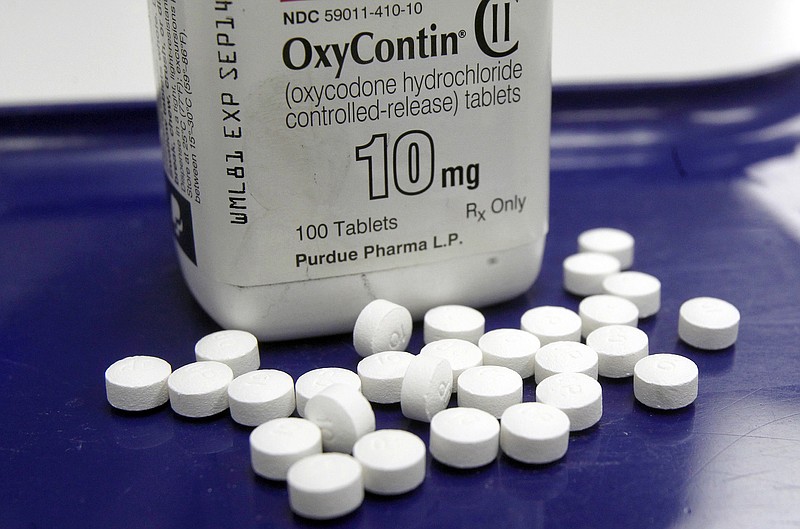Also read...
* TBI warns of fake, deadly prescription drugs hitting the streets in Tennessee
The Obama administration is giving doctors more leeway to treat patients addicted to painkillers or heroin, but it is not clear whether Congress will provide the funds critics say are needed to also provide those patients with counseling.
The federal Health and Human Services Administration announced this week that doctors will now be allowed to prescribe the anti-addiction drug buprenorphine to 275 patients, significantly more than the current limit of 100.
The White House estimates that move will allow the current network of addiction doctors and clinics to treat an additional 10,000 to 90,000 people addicted to heroin or painkillers each year.
But some critics of the administration's move questioned whether there will be enough funding for the counseling they say is needed to keep addicts drug-free.
"We don't have enough trained addiction counseling, including for alcohol which, of course, is an abused substance," said Dr. Thomas Miller, a pain specialist and head of the Hamilton County Regional Health Council's committee on addiction.
The Obama administration is asking Congress for more than $1 billion in funds to fight opioid addiction, and both the House and Senate have passed several different bills to address the issue. Congress is now trying to resolve conflicts among those bills and to figure out a way to fund them.
A key part of the anti-addiction effort is the drug buprenorphine. It is an opioid related to heroin, morphine, and painkillers such as OxyContin and Percocet.
But while buprenorphine is itself an opioid, it does not provide the euphoria delivered by heroin and some painkillers. It does, however, reduce an addict's craving for other drugs and it blocks the pain of withdrawal from those drugs.
In that sense, it is similar to methadone, which is often used to treat heroin addiction.
"It binds in the brain to opiate receptors, and it binds tighter than other drugs, so it keeps a person from being able to use morphine or oxycodone and get high from that," said Dr. John Standridge, medical director of the Chattanooga Council for Alcohol and Drug Abuse Services and past president of the Tennessee Society of Addiction Medicine. "Methadone doesn't bind tighter. If you take other drugs on top of methadone, you get the effect of those other drugs added on."
That lets buprenorphine act as a bridge to sobriety, Standridge said.
"It lets people feel normal for the first time in their lives," he said. "It lets them go to school and raise a family and not be high and not be crazy and not be into the behaviors of addiction."
Buprenorphine was originally seen as a way to decentralize the treatment of addicts. Doctors were limited to prescribing it to only 30 patients in the hope that family or primary care doctors would be convinced to treat addiction patients, Standridge said.
"What they wanted was that doctors all over the country would treat addiction just like they would do diabetes or hypertension," he said. "And it would destigmatize it."
That didn't happen, Strickland said, so health officials, faced with an unprecedented rise in overdose deaths over the past 15 years, from both heroin and prescription painkillers, are now turning to addiction specialists and allowing them to prescribe buprenorphine to many more patients.
In 1999, there were approximately 2,000 deaths in the U.S. from heroin overdoses, and 4,000 from overdoses from painkillers, according to the Centers for Disease Control and Prevention. But in 2014, the latest year for which data is available, heroin overdoses had soared to 10,574, while painkiller overdoses rose to 18,893.
Much of the federal and state anti-addiction effort has focused on reducing the number of painkillers prescribed by doctors, to get rid of so-called "pill mills," where doctors prescribed the pills without determining whether patients actually needed or were using them. Tennessee is one of several states that appear to be making progress in reducing the overall number of prescriptions for painkillers. The number of prescriptions declined by 7 percent between 2013 and 2014, for example.
But while overdose deaths from painkillers actually dropped nationally between 2010 and 2013, from 16,651 to 16,235, before rising again in 2014, heroin overdoses have increased steadily during the same time period, from 3,000 to 10,000. Some critics fear that with heroin a cheap alternative and health care often limited in rural areas, some patients will end up on heroin instead of buprenorphine.
"In the cities, you will see opportunities to rescue [addicts], but you are not going to see that in rural areas," said Dr. Terri Lewis, a patient advocate who moderates the Tennessee Pain Care for All Facebook group. "There just isn't a system of support there."
Lewis argued that until Tennessee improves its health care system in rural areas, addiction will remain a problem.
But Strickland said he believes increasing access to buprenorphine is at least a start for some patients.
"It gives [addicts] the opportunity to work through addiction programs and get the tools they need to taper off of this medicine over time and be clean and sober in a full sense," he said.
Contact staff writer Steve Johnson at 423-757-6673, sjohnson@timesfreepress.com, on Twitter @stevejohnsonTFP, and on Facebook, www. facebook.com/noogahealth.
